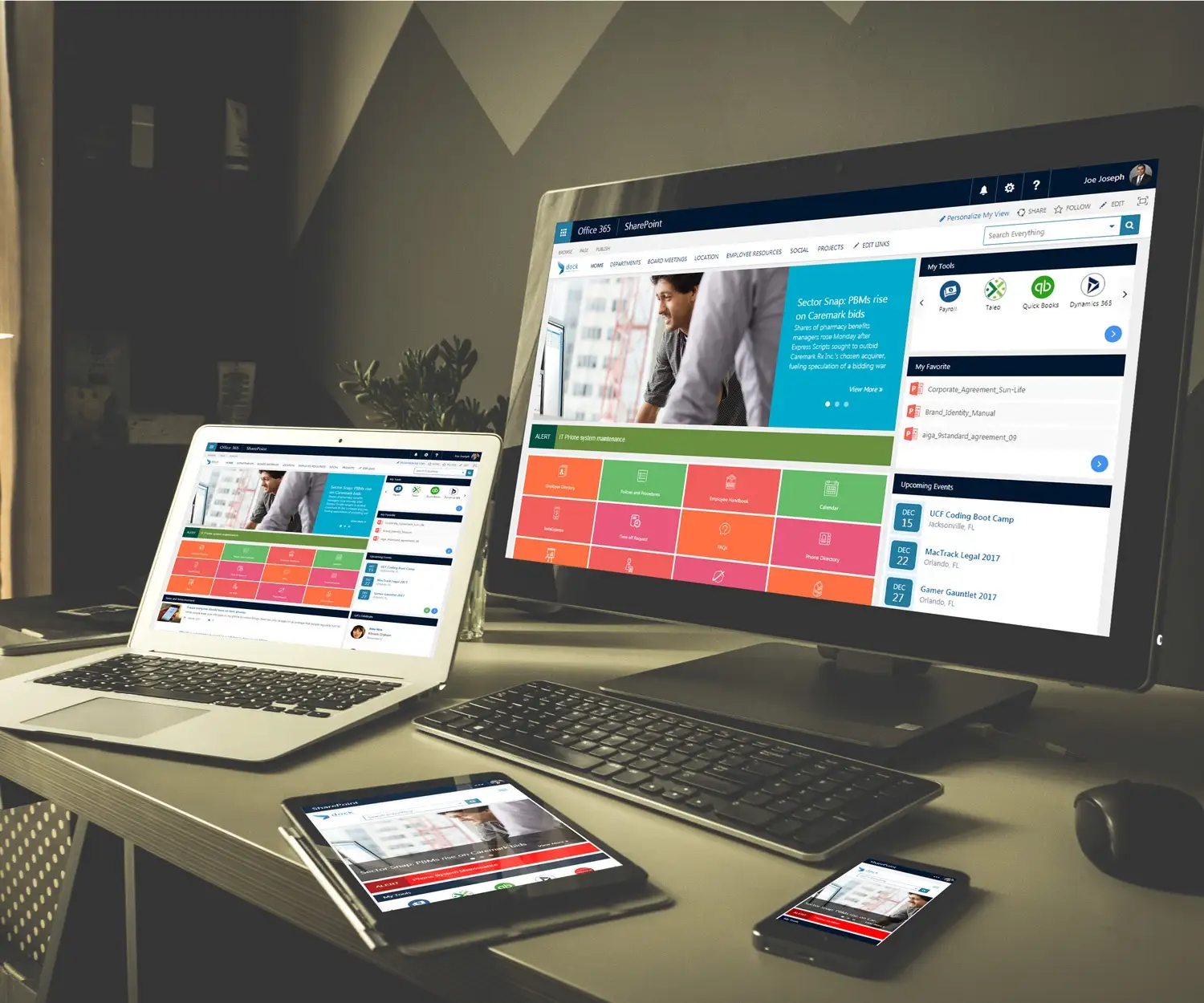SharePoint is a great, highly customizable platform that can help companies accomplish anything they can think of. One of the premiere features is the ability to generate workflows that can automate a lot of your business processes. There are several types of workflows and different ways that you can create them. Today, we want to go over some basic workflows and the steps that you need to follow to create them.
Content:-
- What is a SharePoint Workflow?
- How to Create a Workflow for a List or Library
- How to Create a Simple Approval Workflow in SharePoint
- How to Create an Email Notification Workflow for a SharePoint List
- How to Create an Elevated Permissions Workflow for SharePoint Online
- Conclusion
What is a SharePoint Workflow?
A workflow is a pre-programmed mini-application that allows you to automate a wide range of businesses processes. They provide rules, conditions, and actions for automatic behavior and tasks on lists and libraries that produce some sort of outcome. A workflow runs along a flow chart that checks for various conditions. Depending on how it is programmed it will automatically execute a programmed action depending on the stimulus. For example, you can create a workflow that notifies a person whenever a document needs to be approved. You can do a lot with SharePoint workflows, so let's take a look at some of the things you can do.
How to Create a Workflow for a List or Library
- Find the library you want to create the flow for.
- Find Power Automate under the Automate option in the command bar.
- Click Create a flow.
- Select a flow template from the right-hand panel. You can either choose to use one of the pre-built flows or use one as a base for a custom flow.
- Connect your SharePoint list or library to Power Automate.
- You should be taken to the Power Automate designer. Once here, you should be able to customize your workflow.
- The first action in the flow, or the trigger, determines how your workflow starts. You can add additional actions after the first. These are all dependent on the action before.
- One type of flow performs automatically when an item is added or changed. A second type of flow can be started only after you select an item.
- To start this flow, click the Automate menu in the command bar in SharePoint. The type of trigger you previously selected will determine if the flow is started automatically or manually from the command bar.
- Make sure to add any necessary information or change the default values provided for the template. To modify default values, go to Send Email and then click Edit. The options for the Send Email action include changes to how the email appears to displaying addition fields from the SharePoint item.
- Configure the flow and then click Create Flow.
- After the flow is created, click Done.
This is a general set of instructions for building workflows for any list or library in your SharePoint site. Make sure to follow this whenever you are attempting to build a flow for a list or a library within SharePoint.
How to Create a Simple Approval Workflow in SharePoint
This is a great, simple workflow that lets automates a lot of the approval process and makes it so that people in your organization don't have to play a game of email tag to push a document or file through.
- Open the SharePoint Designer.
- Click File and then Open on your SharePoint site.
- Go to your Task list and check the box Require content approval for submitted items.
- Return to the File tab and click New Item. Choose List workflow. Choose the name and the list of your new approval workflow.
- Click over to the Workflow settings button and then check the necessary boxes in the Start Options section.
- Return to editing your approval workflow. On Step 1 click on Action and then choose Set Workflow variable.
- Click on workflow variable and then choose create new variable. Type the name of the variable and choose its type from the drop-down menu.
- Click on Value and define the workflow look up.
- Add the Condition to this action.
- Define the value of the first hyperlink. For this, choose the Data Source and Field from source from the drop-down menus and click OK.
- Define the value for this second hyperlink and click OK.
- Add the required action to this connection.
- Add Set Content Approval Status action to this current condition. Define the approval status clicking on the status hyperlink and add some comments.
- Click Check for Errors. If there are no mistakes, hit Save and then Publish for your approval workflows.
How to Create an Email Notification Workflow for a SharePoint List
This workflow is great for when multiple people are working on and with a single list. This lets people know when new things are added so that if further action needs to happen with a new item, it can happen ASAP.
- Open SharePoint Designer.
- Open your site.
- Go to Workflows.
- Click on List Workflow and then select your list.
- Add the Send email action.
- A block will be added with a hyperlink saying Email these users.
- Click the hyperlink and configure the Send email action to specific recipients.
- After this, go to Workflow Settings.
- Set up the workflow to start whenever an item is added or created.
- Hit Publish.
How to Create an Elevated Permissions Workflow for SharePoint Online
This workflow is great for automating the processes for handling user requests for additional content or higher level permissions. Before you can build this workflow, you will need to allow a workflow to use add-in permissions on a SharePoint site.
How to Allow a Workflow to Use Add-In Permissions on a SharePoint Site
- Go the the SharePoint site where you want the workflow to run.
- Click on the Settings icon and then open the Site settings page.
- Go to the Site Actions setting and then select Manage site features.
- Locate the feature Workflows can use app permissions and then click Activate.
Now that you've done this, you will have to make it so that your workflow has full control on the site.
How to Grant Full Control Permission to a Workflow
- Select the Settings icon.
- Go to Site settings.
- In Users and Permissions, select Site app permissions (This can only be done by a Site Collection Administrator).
- Copy the client section of the App Identifier.
- Go to the Grant permissions to an app page. You will need to go to the appinv.aspx page of the site.
- Example: https://{hostname}/{site collection}/_layouts/15/appinv.aspx
- Paste the client ID in the App Id field and then click Lookup.
- Paste the following code in the Permission Request XML field to grant full control permission.
- INSERT CODE HERE DINGUS
- Select Create.
- You are then asked to trust the workflow add-in. Click Trust It.
After you've done this, it's time to wrap the workflow actions inside an App Step. This will wrap the Send an Email action inside an App Step.
How to Wrap Actions Inside an App Step
- Open the app catalog site in SharePoint Designer.
- Create a new Custom List on which to run the workflow. In this example, the list name is App Demo.
- Click on Workflows in the navigation window.
- Create a new List Workflow for the App Demo list.
- Insert an App Step.
- Insert Send an Email into the App Step.
- Select the Address button in the To field. Now click Workflow Lookup for a User, then select Add.
- Enter the Created By field as the lookup value.
- Enter Email from the App Demo list in the email message body.
- Select OK to return to the workflow.
- Click on the Workflow Settings icon.
- Clear the check box next to Automatically update the workflow status to the current stage name.
- Click Publish.
Conclusion
As we said previously, SharePoint is an incredibly powerful platform that you can customize to do all sorts of things. Learn how to use these basic workflows to get started automating different process in your SharePoint online site to save time and work more efficiently. If you're interested in learning more advanced SharePoint concepts, make sure to check back on our blog every day for new SharePoint blogs. You can also sign up for our mailing list to get an update every time we post a new SharePoint blog.
Book a Live demo
Schedule a live demo of Dock 365's Contract Management Software now.

Written by Quentin Russell
Quentin Russell is a Content Specialist with knowledge of Content Marketing and Social Media Marketing.







